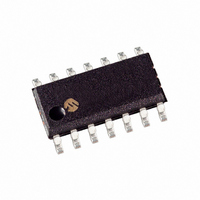PIC16F630-I/SL Microchip Technology, PIC16F630-I/SL Datasheet - Page 71

PIC16F630-I/SL
Manufacturer Part Number
PIC16F630-I/SL
Description
IC MCU FLASH 1KX14 EEPROM 14SOIC
Manufacturer
Microchip Technology
Series
PIC® 16Fr
Datasheets
1.PIC16F616T-ISL.pdf
(8 pages)
2.PIC12F629T-ISN.pdf
(24 pages)
3.PIC16F630-ISL.pdf
(132 pages)
4.PIC16F630-ISL.pdf
(2 pages)
5.PIC16F630-ISL.pdf
(10 pages)
6.PIC16F676-EP.pdf
(132 pages)
7.PIC16F676-ISL.pdf
(130 pages)
Specifications of PIC16F630-I/SL
Program Memory Type
FLASH
Program Memory Size
1.75KB (1K x 14)
Package / Case
14-SOIC (3.9mm Width), 14-SOL
Core Processor
PIC
Core Size
8-Bit
Speed
20MHz
Peripherals
Brown-out Detect/Reset, POR, WDT
Number Of I /o
12
Eeprom Size
128 x 8
Ram Size
64 x 8
Voltage - Supply (vcc/vdd)
2 V ~ 5.5 V
Oscillator Type
Internal
Operating Temperature
-40°C ~ 85°C
Processor Series
PIC16F
Core
PIC
Data Bus Width
8 bit
Data Ram Size
64 B
Interface Type
RS- 232/USB
Maximum Clock Frequency
20 MHz
Number Of Programmable I/os
12
Number Of Timers
2
Operating Supply Voltage
2 V to 5.5 V
Maximum Operating Temperature
+ 85 C
Mounting Style
SMD/SMT
3rd Party Development Tools
52715-96, 52716-328, 52717-734
Development Tools By Supplier
PG164130, DV164035, DV244005, DV164005, PG164120, ICE2000, DM163014, DM164120-4
Minimum Operating Temperature
- 40 C
Package
14SOIC N
Device Core
PIC
Family Name
PIC16
Maximum Speed
20 MHz
Lead Free Status / RoHS Status
Lead free / RoHS Compliant
Data Converters
-
Connectivity
-
Lead Free Status / Rohs Status
Lead free / RoHS Compliant
Available stocks
Company
Part Number
Manufacturer
Quantity
Price
Company:
Part Number:
PIC16F630-I/SL
Manufacturer:
TriQuint
Quantity:
1 200
Company:
Part Number:
PIC16F630-I/SL
Manufacturer:
MICROCHI
Quantity:
1 743
Part Number:
PIC16F630-I/SL
Manufacturer:
MICROCHIP/微芯
Quantity:
20 000
9.8
If
programmed, the on-chip program memory can be
read out for verification purposes.
9.9
Four memory locations (2000h-2003h) are designated
as ID locations where the user can store checksum or
other code identification numbers. These locations are
not accessible during normal execution but are
readable and writable during Program/Verify. Only the
Least Significant 7 bits of the ID locations are used.
9.10
The PIC16F630/676 microcontrollers can be serially
programmed while in the end application circuit. This is
simply done with two lines for clock and data, and three
other lines for:
• power
• ground
• programming voltage
This allows customers to manufacture boards with
unprogrammed devices and then program the micro-
controller just before shipping the product. This also
allows the most recent firmware or a custom firmware
to be programmed.
The device is placed into a Program/Verify mode by
holding the RA0 and RA1 pins low, while raising the
MCLR (V
Specification). RA0 becomes the programming data
and RA1 becomes the programming clock. Both RA0
and RA1 are Schmitt Trigger inputs in this mode.
After Reset, to place the device into Programming/Ver-
ify mode, the program counter (PC) is at location 00h.
A 6-bit command is then supplied to the device.
Depending on the command, 14 bits of program data
are then supplied to or from the device, depending on
whether the command was a load or a read. For
complete details of serial programming, please refer to
the PIC16F630/676 Programming Specification.
A typical In-Circuit Serial Programming connection is
shown in Figure 9-14.
2010 Microchip Technology Inc.
Note:
the
Code Protection
ID Locations
In-Circuit Serial Programming
code
PP
The entire data EEPROM and Flash
program memory will be erased when the
code protection is turned off. The INTOSC
calibration data is also erased. See
PIC16F630/676 Programming Specifica-
tion for more information.
) pin from V
protection
IL
to V
bit(s)
IHH
(see Programming
have
not
been
FIGURE 9-14:
9.11
Since in-circuit debugging requires the loss of clock,
data and MCLR pins, MPLAB
an 14-pin device is not practical. A special 20-pin
PIC16F676-ICD device is used with MPLAB ICD 2 to
provide separate clock, data and MCLR pins and frees
all normally available pins to the user.
This special ICD device is mounted on the top of the
header and its signals are routed to the MPLAB ICD 2
connector. On the bottom of the header is an 14-pin
socket that plugs into the user’s target via the 14-pin
stand-off connector.
When the ICD pin on the PIC16F676-ICD device is
held low, the In-Circuit Debugger functionality is
enabled. This function allows simple debugging
functions when used with MPLAB ICD 2. When the
microcontroller has this feature enabled, some of the
resources are not available for general use. Table 9-10
shows
background debugger:
TABLE 9-10:
For more information, see 14-Pin MPLAB ICD 2
Header Information Sheet (DS51292) available on
Microchip’s web site (www.microchip.com).
External
Connector
Signals
Data I/O
Program Memory
CLK
+5V
V
which
In-Circuit Debugger
0V
PP
I/O pins
Stack
PIC16F630/676
features
DEBUGGER RESOURCES
To Normal
Connections
To Normal
Connections
TYPICAL IN-CIRCUIT
SERIAL PROGRAMMING
CONNECTION
are
Address 0h must be NOP
®
ICD 2 development with
ICDCLK, ICDDATA
consumed
300h-3FEh
V
V
RA3/MCLR/V
RA1
RA0
V
DS40039F-page 71
PIC16F630/676
DD
SS
DD
1 level
by
PP
the


















